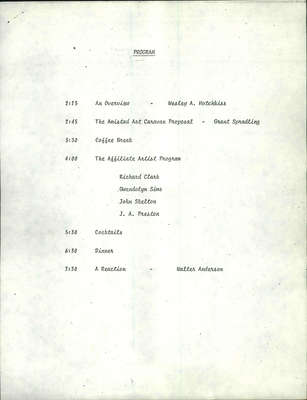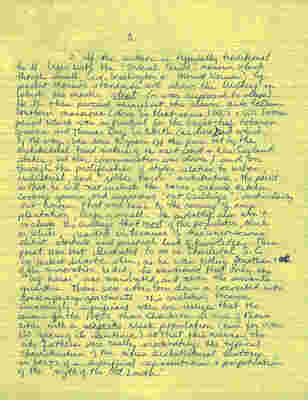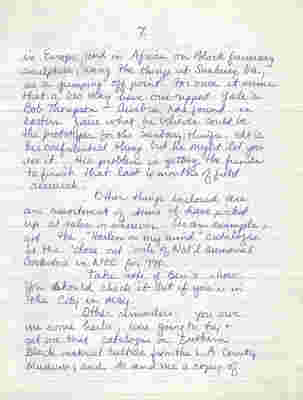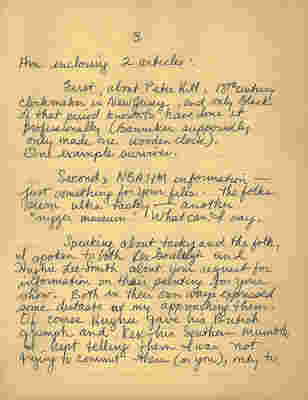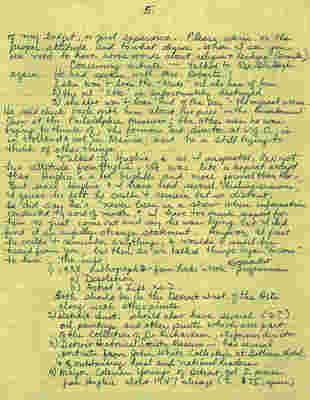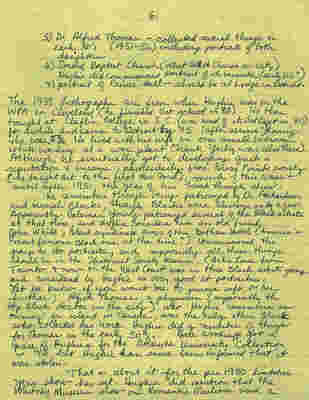Pages That Need Review
MS01.03.03 - Box 01 - Folder 03 - Amistad II - Art Caravan Meeting Notes, 1973-1975
4
Program
2:15 An Overview - Wesley A. Hotchkiss
2:45 The Amistad Art Caravan Proposal - Grant Spradling
3:30 Coffee Break
4:00 The Affiliate Artist Program
Richard Clark Gwendolyn Sims John Skelton J.A. Preston
5:30 Cocktails
6:30 Dinner
7:30 A Reaction - Walter Anderson
5
Grant Spractling - Nov 15, 1973
Staff person: planning developer Edward Grady Rochester, NY
Build in a plan that after six months the person could get out.
Office space not a problem.
$15,000 to get started: planning and 9,000.00 [crossed out 000] Development into ------------- 6-
Vans: $300,000 300,000 ------------ Stage & performing/ 600,000
Visual Arts: Exhibition Send for light and screen in Freuhoff Builder: Library & Strict: AV Room
General Motors:
Art motion = leave something/Carlton
see-- visual also [4 horizontal lines]
send any photographs to archive: [3 vertical lines]
MS01.05.00 - Box 21 - Folder 14 - Jones, Steven - Correspondence, 1974-1979
3
3.
2. If the author is typically traditional he'll begin with the "Federal Period" mansion which though small (i.e. Washington's Mount Vernon) by present Mansion standards will show the building in which the master slept (or was supposed to sleep). He'll then proceed throughout the classic antebellum Southern mansions (done in that same 1840's & 50's boom period which was so fruitful for the (bright ?)-leaf tobacco growers adn Thomas Day in North Carolina and which, by the way, were some 40 years off the pace set by the architectural trend makers of the east coast & New England states, (but ?) then communication was slower) and on through the proliferation of styles relative to urban, industrial, and "robber baron" architecture, the point is that he will not include the barns, outside kitchen cooking spaces, and supportive "out buildings", particulary out-houses, that were basic to the running of any plantation, large or small. He probably also won't include the buildings that most of the population, Black or white, resided in because of his unconscious elitist attitude and personal lack of knowledge, this ponit was best illustrated to me in Charleston, S. C. by herbert deCosta when, as he was telling Jonathan & me of the rennovation he did, he mentioned that only the "big house" was rennovated, and never the servants quarters. Those were either torn down or converted into contemporary apartments. This revelation became increasingly significant when one realizes that the census for the 1840's shows Charleston as one of those cities with a majority Black population (true for over 150 years of its existence) so that this means the city fathers were really eradicating the typical characteristics of the cities architectural history in favor of a superficial representation & perpetuation fo the "myth of the Old South."
13
7.
in Europe, and in Africa on Black funerary sculpture, using the things at Sunbury, Ga., as a jumping off point. For once it seems that a bro may have one-upped Yale's Bob Thompson - Ausbra has found in eastern Zaire what he believes could be the prototypes for the Sunbury things. It's his confidential thing but he might let you use it. His problem is getting the funds to finish that last 6 months of field research. Other things enclosed are an assortment of items I have picked up at sales or wherever. As an example, got the "Harlem on my mind" calalogue at the "close-out" sale of Nat'l Memorial Bookstore in NYC for 99 (cents ?). Take note of Ben's show. You should check it out if you're in the City in May. Other reminders: you owe me some herbs; were going to try & get me that catalogue on Southern Black material culture from the L.A. County Museum; and to send me a copy of
24
3.
Am (?) enclosing 2 articles:
First, about Peter Hill, 18th century clockmaker in New Jersey, and only Black of that period known to have done it professionally (Banneker supposedly only made one wooden clock). One example survives.
Second, NBAI & M (?) information - just something for your files. The folks seem ultra tacky - another "nigger museum." What can I say.
Speaking about tacky and the folk, I spoken to both Rex Gouleigh (?) and Hughie Lee-Smith about your request for information on their painting for your show. Both in their own ways expressed some distaste at my approaching them. Of course Hughie gave his British grumph and Rex his Southern mumble. I kept telling them I was not trying to commit them (or you), only to
26
5.
After telling him I was there to answer all the how, when, etc., I told him about how the big white professional shows were done, how they didn't like the idea of a Black curator for a major exhibit, & how this would be the Black show of the decade ( fighting back that urge to tell him that as a second-rate artist he was truly fortunate to have me coming there to ask him in the first place). But I was cool - remembering your training. Then he went through how he really didn't like all Black shows anyway and how it was such a step backward to have so many, and how back in the 50's (wouldn't you know he'd bring up that tired decade), he and a Black sculptress were the only 2 Blacks in an "American Art show" at the Anderson (?) Gallery in New York, [swish arrow (?)] "one of the most renowned."
After I told him how white critics neither have nor will anytime
27
6.
soon seriously consider Black artists artists, I asked him how many shows he's been in recently and where. He then started complaining about how he's been overlooked and hasn't been getting the recognition he should have, and remembering his days in Chicago.
Finally after letting him know that I or my family were well acquainted with all those few outstanding people in Chicago that have been involved with art on a long term basis, I was able to get him to where he was willing to talk about his own work. That is when I found out he really didn't remember what he's done or where it is, for the most part. And besides that, he considers that his major work has been done since 1950 ( & from the looks of things I would hope it still hasn't been done).
So after going through a lot of
35
5.
of my budget, or just experience. Please advise on the proper attitude and to what degree. When I see you we need to have some words about religion & lechery (smile). Concerning artists - talked to Rex Gouleigh (?) again. He had spoken with Mrs. Roberts : 1) she won't loan the "Nude" oil she has of his 2) the oil "Etta" is unfortunately destroyed 3) she also won't loan "End of the Day" - the migrant scene. He said check back with him about his piece in the Bicentennial Show at the Philadelphia Museum; the other man he was trying to think of, the former art director at U of C., is in Holland & not in Mexico, and he's still trying to think of other things. Talked to Hughie, & as I suspected, Rex got his attitude from Hughie. It was like a repeat except that Hughie's a lot brighter and more formal than Rex. But since Hughie & I have had several "dishing sessions," I guess he felt he couldn't remain but so distant. He did say he's "never been in a show where information conducted by word of mouth." I have too much respect for him to just come out and say he was lying but I did find it an awfully strange statement. Anyway, at first he couldn't remember anything, & wouldn't until he heard from you, but then as we talked things began "to come" to him. The info: 1) 1938 Lithographs from Locke's book - Negro in Art prizewinners a) Desolation b) Artist's Life no.2. Both should be in the Detroit Inst. of the Arts along with other prints. 2) Detroit Inst. should also have several (2?) oil paintings and other prints which were part of the collection of Dr. Richardson, its former director 3) Detroit Historical Society Museum - has several portraits from John White Collection at Gotham Hotel [arrow] of outstanding local and national leaders 4) Mayor Coleman Young of Detroit got 2 pieces from Hughie about 1947 cheap (c $75. apiece)
36
6.
5) Dr. Alfred Thomas - collected several things in early 50's (1951-56) including portraits of both daughters 6) Second Babtist Church (oldest Black Church in city) Hughie did commissioned portrait of its minister (early 50's?) 7) portrait of Prince Hall - should be at Lodge in Detroit. The 1938 Lithographs are from when Hughie was on the WPA in Cleveland (he finished Art school in '38). He then taught at Claflin College in S.C. (was head of its Art Dept in '40). for awhile and came to Detroit by '45 [after service?) during the war. He lived with his wife in one small bedroom while working at a war plant (Frank Yerly was also there). Although he eventually got to developing quite a reputation & income, particularly from Gross Pointe society (he taught art to the first Mrs. Ford), much of this wasn't until after 1951, the year of his break through show. He remembers though being patronized by Dr. Richardson and several Blacks, though Blacks were always only a few. Apparently Coleman Young patronized several of the Black artists at that time, and Hughie considers him an old friend. John White, Black syndicate owner of the Gotham Hotel (America's most famous Black one at the time?) commissioned the group to do portraits, and supposedly all these things should be in the Historical Society Museum. (Artis Lane from Toronto & now on the West Coast was in this Black Artists group and considered by Hughie as very good at portraiture. Let me know if you want me to pursue info on her further.) Alfred Thomas, a physician (supposedly the top Black doctor in the city) who Hughie remembers as owning an island in Canada, was the only other Black who collected his work. Hughie did a number of things for Thomas in the early 50's. Hale Woodruff got a piece of Hughie's for the Atlanta University Collection in '43 but Hughie has since been informed that it was stolen. That's about it for the pre 1950 limitation your show has set. Hughie did mention that the Whitney Museum show on Romantic Realism used a
